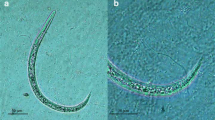Abstract
This experiment has been conducted to evaluate the viability of Angiostrongylus vasorum L1 under different conditions of temperature and humidity. In order to assess the viability, fox faecal pellets containing first stage larvae (L1) were exposed to relative humidity (RH) 95% and 75%, and to different temperatures (5°C, 18°C) and at fluctuating conditions ranging from −5°C to +5°C. Moreover, larval viability under outdoor conditions in April was also observed. Survival of the larvae was strongly influenced by temperature; however, humidity did not show any significant influence on viability. In controlled condition, 100% of the larvae were found motile and active; whereas, around 14% and 19% of the larvae kept at 5°C remained viable at RH 95% and RH 75%, respectively after 78 h. All of the larvae kept at 18°C died after 66 h. In outdoor condition, larval survivability reduced to 18% after 66 h, and in fluctuation temperature viable larvae were observed in both control and experimental conditions (15%) after 78 h.



Similar content being viewed by others
References
Barutzki D, Schaper R (2009) Natural infections of Angiostrongylus vasorum and Crenosoma vulpis in dogs in Germany (2007–2009). Parasitol Res 105:39–48
Bolt G, Monrad J, Henriksen P, Dietz HH, Koch J, Bindseil E, Jensen AL (1992) The fox (Vulpes vulpes) as a reservoir for canine angiostrongylosis in Denmark. Field survey and experimental infections. Acta Vet Scand 33:357–362
Bourdeau P (1993) Canine Angiostrongylus vasorum infestation. Recl Med Vet 169:401–407, Abstract in English
Ferdushy T, Kapel CMO, Webster P, Al-Sabi MNS, Grønvold JR (2009) The occurrence of Angiostrongylus vasorum in terrestrial slugs from forests and parks in the Copenhagen area, Denmark. J Helminthol 83:379–383
Ferdushy T, Kapel CMO, Webster P, Al-Sabi MNS, Grønvold JR (2010) The effect of temperature and host age on the infectivity and development of Angiostrongylus vasorum in the slug Arion lusitanicus. Parasitol Res 107:147–151
Forrester DJ, Senger CM (1963) Effect of temperature and humidity on survival of first stage Protostrongylus stilesi larvae. Expl Parasitoly 13:83–89
Forrester SG, Lankester MW (1998) Over-winter survival of first-stage larvae of Parelaphostrongylus tenuis (Nematoda: Protostrongylida). Can J Zool 76(4): 704-710
Guilhon J, Cens B (1973) Angiostrongylus vasorum (Baillet, 1866) Etude biologique et morphologoque. (Angiostrongylus vasorum (Baillet, 1866). Morphological and biological study). Ann Parasit Hum Comp 48:567–596, Abstract in English
Hardon T (2001) Den stænk tætte Baermann Undersøgelse (The splash-proof Baermann study). Dansk Veterinaer Tidskrift (Danish Veterinary Journal), nr.2. http://dddweb.ddd.dk/pages/artikel.asp/Id=242. Accessed 23 Feb 2008
Hansson I (1974) Seasonal and environmental conditions affecting the invasion of mustelids by larvae of the nematode Skrjabingylus nasicola. OIKOS 25:61–70
Jeffery RA, Lankester MW, McGrath MJ, Whitney HG (2004) Angiostrongylus vasorum and Crenosoma vulpis in red foxes (Vulpes vulpes) in Newfoundland, Canada. Can J Zool 82:66–74
Lankester MW, Anderson RC (1968) Gastropods as intermediate hosts of Pneumostrongylus tenuis Dougherty of white-tailed deer. Can J Zool 46:373–383
Lorentzen G, Halvorsen O (1986) Survival of first stage larva of the metastrongyloid nematode Elaphostrongylus rangiferi under various conditions of temperature and humidity. Holractic Ecol 9:301–304
Morgen ER, Jeffeires R, Krajewski M, Ward P, Shaw SE (2009) Canine pulmonary angiostrongylosis: the influence of climate on parasite distribution. Parasitol Int 58:406–410
Rose JH (1957) Observations on the bionomics of the free-living first stage larvae of the sheep lung worm, Muellerius capillaries. J Helminthol 31:17–28
Rosen L, Ash LR, Wallace GD (1970) Life history of the canine lungworm Angiostrongylus vasorum (Baillet). Am J Vet Res 31:131–142
Sawabe K, Makiya K (1995) Comparative infectivity and survival of first-stage larvae of Angiostrongylus contonensis and Angiostrongylus malaysiensis. J Parasitol 81:228–233
Shostak AW, Samuel WM (1984) Moisture and temperature effects on survival and infectivity of first stage larvae of Parelaphostrongylus odocoilei and P. tenuis (Nematoda: Metastrongyloidea). J Parasitol 70:261–269
Stromberg BE (1997) Environmental factors influencing transmission of parasites. Vet Parasitol 72:247–264
Taubert A, Pantchev N, Vrhovec MG, Bauer C, Hermosilla C (2009) Lungworm infections (Angiostrongylus vasorum, Crenosoma vulpis, Aelurostrongylus abstrusus) in dogs and cats in Germany and Denmark in 2003–2007. Vet Parasitol 159:175–180
Author information
Authors and Affiliations
Corresponding author
Rights and permissions
About this article
Cite this article
Ferdushy, T., Hasan, M.T. Survival of first stage larvae (L1) of Angiostrongylus vasorum under various conditions of temperature and humidity. Parasitol Res 107, 1323–1327 (2010). https://doi.org/10.1007/s00436-010-2004-x
Received:
Accepted:
Published:
Issue Date:
DOI: https://doi.org/10.1007/s00436-010-2004-x




